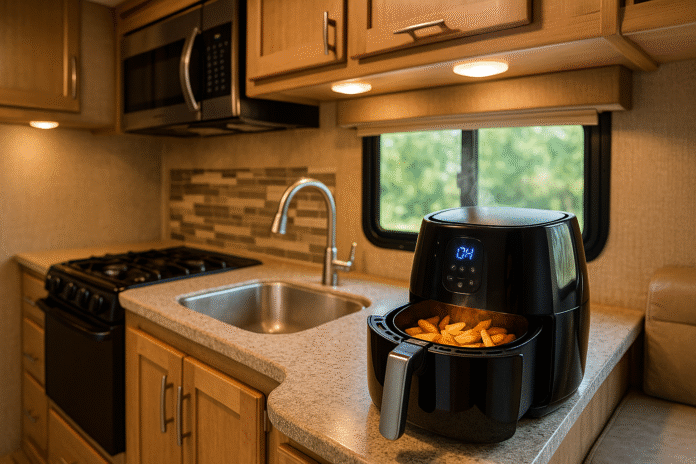
If you love the idea of crispy, home-cooked meals while exploring the open road, you might be wondering about your cooking options in a camper. Can you run an air fryer in a camper with electricity? Yes, you can run an air fryer in a camper, as long as your RV’s electrical system can handle the power load.
Most modern RVs with a 30-amp or 50-amp hookup can support an air fryer safely, especially when used wisely alongside other appliances. That’s why many RVers across the U.S. are embracing air fryers for quick, healthy, and delicious meals on the road. In this guide, we’ll explore everything you need to know—from power requirements to the best models of Air Fryers for RV living—so you can decide if an air fryer is the right fit for your camper lifestyle.
Understanding RV Electrical Systems
Before plugging in any appliance, it’s essential to understand how your RV’s power works. Your RV’s electrical system has different capabilities and limitations.
Most campers are equipped with either a 30-amp or 50-amp electrical system:
- A 30-amp system provides up to 3,600 watts (120V x 30A).
- A 50-amp system can offer up to 12,000 watts (split between two 120V legs).
This might sound like a lot, but RVs can safely run many household appliances when connected to shore power, including air conditioner, fridge, water heater, microwave, and more.
When you are running these appliances, your available wattage shrinks fast. High-wattage devices like air fryers, instant pots, and electric heaters require careful power management. On a 30-amp system, an air fryer might consume half your available power, leaving little for other necessities like air conditioning or water heaters.
So, can an air fryer work in that mix? Yes—but you need to plan.
How Much Power Does an Air Fryer Use?
Air fryers typically use between 800 to 1,800 watts, depending on size and brand. Where most popular models fall in the 1200-1500 watt range.
| Air Fryer Size | Average Wattage | Ideal For |
| Small (2-3 qt) | 800-1,200 W | Solo travelers, couples |
| Medium (4-5 qt) | 1,200-1,500 W | Small families |
| Large (6+ qt) | 1,500-1,800+ W | Full-time RVers, families |
This power draw is significant in an RV context.
For 30-amp systems:
- A 1500W air fryer uses approximately 42% of your total available power
- Running alongside an air conditioner (1500W) could easily trip your breaker
- You’ll need to turn off high-draw appliances before using your air fryer
For 50-amp systems:
- Power management is less restrictive
- Multiple high-draw appliances can run simultaneously
- Still advisable to monitor total load during peak usage times
To avoid overloading your electrical system:
- Check the wattage rating on your air fryer (usually printed on the bottom or in the manual)
- Calculate your current power usage before turning on the air fryer
- Consider using a power monitor like a Kill-A-Watt device to track consumption
✅ Pro Tip: To avoid tripping your RV’s breaker, don’t use high-wattage appliances at the same time as your air fryer. For example, avoid using the microwave or coffee maker during air frying.
Can You Use an Air Fryer on RV Battery or Solar Power?
If you’re camping off-grid (boondocking), your ability to use an air fryer depends on your battery capacity and whether you have a power inverter.
You’ll need:
- A pure sine wave inverter rated at least 2,000 watts
- A robust battery bank (preferably lithium-ion)
- Adequate solar panel backup or generator
Inverter Requirements: You’ll need a pure sine wave inverter rated for at least double the air fryer’s wattage. For a 1500W air fryer, a 3000W inverter is recommended to handle the startup surge.
Battery Drain Calculation:
- A 1500W air fryer running for 20 minutes consumes about 500 watt-hours
- On a typical 12V deep cycle battery bank (200Ah), this represents significant drain
- Using the 50% discharge rule for battery health, you could only run the air fryer a few times before needing to recharge
Solar Considerations:
- Minimum 400W of solar panels would be needed just to recover from one air fryer cooking session
- Weather-dependent recharging makes this unreliable for daily use
- Best paired with a generator backup for cloudy days
For most RVers, air fryer use during boondocking is impractical unless you have a substantial battery bank (400Ah+), significant solar capacity, or plan to run a generator regularly.
💡 Reality Check: While technically possible, air fryers aren’t ideal for boondocking unless you have a serious solar or generator setup.
Cooking with an Air Fryer in an RV – Pros & Cons
✅ Pros:
- Fast cooking: Air fryers preheat rapidly and cook food within 10–20 minutes, faster than conventional methods, which means less time running electrical appliances.
- Less mess: Little to no oil means less splatter and easier cleanup—a significant advantage in small RV kitchens with limited water resources.
- Compact Design: Most air fryers have a small footprint compared to conventional ovens, making them ideal for limited counter space in RVs.
- Versatility: Modern air fryers can roast, bake, and dehydrate in addition to “frying,” potentially replacing multiple appliances.
❌ Cons:
- High power draw: The high wattage draw can be problematic, especially in smaller RVs with 30-amp service. Requires caution if used with other devices.
- Heat and Odors: Air fryers produce heat and cooking odors that can quickly fill a small RV space if ventilation is inadequate.
- Noise Level: The fans in air fryers can be noticeable in small spaces, potentially disturbing the peaceful camping experience.
Comparison with Other RV Cooking Options
| Appliance | Power Usage | Cooking Speed | Versatility | Storage | Best For |
| Air Fryer | 800-1800W | Fast | High | Medium | Shore power sites |
| Microwave | 700-1200W | Very Fast | Medium | Built-in | Quick reheating |
| Propane Stove | None (Propane) | Medium | High | Built-in | Off-grid cooking |
| Induction Cooktop | 1200-1800W | Fast | Medium | Small | Precise cooking |
Best Air Fryers for RV Living (Our Top Picks)
Compact Air Fryers for Small RVs
1. CHEFMAN 2QT Mini Air Fryer
- Wattage – 900 Watts
- Capacity – 2 Quarts (1.9L)
- Footprint – 10″D x 10″W x 8.3″H
- Weight – 5.9 Pounds (2.68 Kg)
- Special Features – Touch control, Digital, Nonstick, Dishwasher Safe, Shake Reminder
2. COSORI 2.1QT, Small & Mini 4-in-1 Air Fryer
- Wattage – 900 Watts
- Capacity – 2.1 Quarts (2L)
- Footprint – 10.1″D x 8.3″W x 10.5″H
- Weight – 4.87 Pounds (2.21 Kg)
- Special Features – 4 Cooking Functions, Temperature Control, Timer, In-App Recipes with Nutrition Facts, Automatic Shut-Off, Programmable.
Multi-Function Air Fryers for Full-Time RVers
1. Ninja Air Fryer Pro AF-141 5QT
- Wattage – 1750 Watts
- Capacity – 5 Quarts (4.69L)
- Footprint – 14.84 “D x 11.3 “W x 10.39 “H
- Weight – 10.58 Pounds (4.8 Kg)
- Special Features – 4-in-1 FUNCTIONALITY: Air Fry, Roast, Reheat, and Dehydrate
Tips for Using an Air Fryer Safely in Your RV
Proper Placement and Ventilation
- Place your air fryer at least 5 inches from walls or cabinets
- Ensure the exhaust vent has unrestricted airflow
- Consider using near an open window or under the range hood if possible
- Never place on stovetops or near water sources
Power Management Strategies
- Turn off air conditioning before running the air fryer
- Avoid running multiple high-draw appliances simultaneously
- Use during non-peak times (avoid late afternoon when AC demand is highest)
- Consider a surge protector specifically designed for RVs
Monitoring Your Power Draw
- Install an electrical management system (EMS) to prevent overloads
- Use a simple plug-in wattage meter to track consumption
- Know the signs of an overloaded system: dimming lights, tripping breakers
Is an Air Fryer a Healthy Cooking Option on the Road?
An air fryer can be a game-changer for health-conscious RVers. Using minimal oil (typically 70-80% less than traditional frying), air fryers produce foods with significantly lower fat content while maintaining crispy textures.
For RVers balancing adventure with nutrition, air fryers offer:
- Quick preparation of fresh vegetables
- Ability to cook lean proteins efficiently
- Less temptation to rely on fast food during travel days
RV-Friendly Air Fryer Meals:
- Breakfast: Quick frittatas or hash brown cups
- Lunch: Crispy chickpeas or vegetable chips
- Dinner: Salmon fillets with roasted vegetables
- Snacks: Homemade jerky or dried fruit (using dehydrate function)
Frequently Asked Questions (FAQs)
Can I run an air fryer in my camper?
Yes, you can run an air fryer in your camper—as long as your RV’s electrical system can handle the appliance’s wattage. Most air fryers draw between 800 to 1,500 watts, which fits well within the limits of both 30-amp and 50-amp RV systems. Just be cautious not to run other high-wattage appliances at the same time to avoid tripping your circuit.
Can I use an air fryer on a campsite?
Yes, using an air fryer at a campsite is possible if you have access to shore power (like at RV parks) or a properly rated generator or inverter system. Make sure the power source can handle the air fryer’s wattage and that extension cords or adapters are heavy-duty and safe for outdoor use.
Can you run an air fryer on a portable power station?
Yes, but it depends on the power station’s output. Many portable power stations can run smaller air fryers (around 800–1000W), especially if they offer a pure sine wave inverter and at least a 1000W continuous power rating. You’ll need to check your specific air fryer’s wattage and ensure your station can provide enough watts and battery capacity for the cooking duration.
How to power an air fryer camping?
You can power an air fryer while camping using:
- Shore power at RV parks or campgrounds with electrical hookups
- A portable generator (minimum 1500W recommended for most models)
- A solar power setup with batteries and an inverter rated to handle your air fryer’s wattage
- A portable power station, if sized correctly for your device
Always verify power output and safety compatibility before use.
How many amps does an air fryer take?
To calculate amps: Amps = Watts ÷ Volts
For example, a 1500W air fryer on a 120V system: 1500 ÷ 120 = 12.5 amps.
Most air fryers draw between 7 to 13 amps, depending on their wattage. This is important when considering your RV’s overall amp limit (especially with a 30-amp system).
Can an air fryer run on 12V?
Not directly. Most air fryers are designed for standard 120V AC outlets. To run one from a 12V system (like a car battery or RV battery), you’ll need a high-quality inverter that converts 12V DC to 120V AC and can handle the air fryer’s wattage. Without an inverter, a typical air fryer will not work on 12V power alone.
So, Is an Air Fryer Worth It for Your RV Adventures?
After weighing all factors, an air fryer can be a valuable addition to your RV kitchen under the right circumstances.
Best Scenarios for RV Air Fryer Use:
- Primarily camping at locations with shore power
- RVs with 50-amp electrical service
- Travelers who prioritize healthy, home-cooked meals
- Full-timers with adequate storage space
Consider Alternatives When:
- You primarily boondock or dry camp
- Your RV has limited power capacity (30-amp or less)
- Storage space is at an absolute premium
- You already have a convection microwave
For most RVers who frequently use campgrounds with electrical hookups, a properly sized air fryer balances convenience, cooking performance, and power requirements—making it a worthwhile investment for your mobile kitchen.
Final Thoughts
An air fryer can be a game-changing RV kitchen appliance—if you use it wisely. It saves time, cooks healthy meals, and fits easily into most camper kitchens. Just keep an eye on your power draw, and you’ll be frying up crispy meals on the road in no time.












